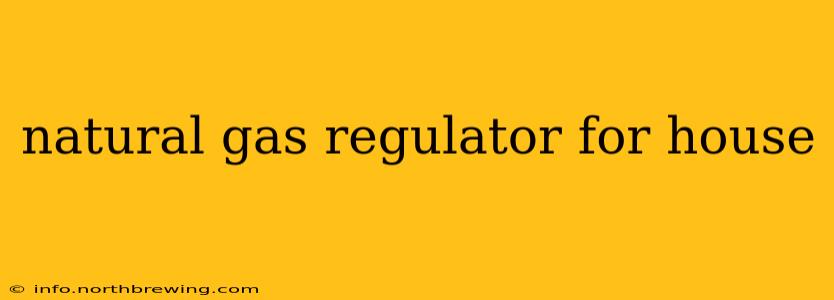Natural gas is a vital resource for many homes, providing heating, hot water, and sometimes even cooking fuel. But before this gas reaches your appliances, it needs safe and efficient regulation. This guide explores natural gas regulators for houses, answering common questions and helping you understand their crucial role in home safety.
What is a Natural Gas Regulator?
A natural gas regulator is a pressure-reducing valve that controls the flow of natural gas from the main supply line to your home's appliances. High-pressure gas from the utility company is reduced to a much lower, safer pressure suitable for domestic use. Without this regulator, the high-pressure gas could pose a significant risk of leaks, explosions, and fires. It's a critical safety device that's often overlooked until a problem arises.
Where is the Natural Gas Regulator Located?
The location of your natural gas regulator varies. It's typically found outside your home, near where the gas line enters your property. Sometimes it's located in a small metal enclosure or directly attached to the gas meter. However, in some installations, it might be inside a utility room, though this is less common. If you're unsure of its location, consult your local gas utility company. They will be able to identify its location and assist with any concerns.
How Does a Natural Gas Regulator Work?
A natural gas regulator uses a diaphragm and a spring mechanism. High-pressure gas enters the regulator, pushing against the diaphragm. The spring resists this pressure, maintaining a consistent, low-pressure output. The diaphragm and spring work together to precisely control the gas flow, preventing over-pressurization and ensuring a safe and consistent supply to your home's appliances. Regular maintenance is essential to ensure this mechanism continues functioning correctly.
What are the Different Types of Natural Gas Regulators?
Several types of natural gas regulators exist, each designed for specific applications and pressure ranges. These differences are primarily based on pressure levels and the capacity to regulate gas flow. While specifics can be complex, understanding the general types is helpful. You shouldn't attempt to repair or replace your regulator yourself unless you're a qualified gas technician.
2-Stage Regulators:
These regulators reduce the pressure in two stages, offering more precise control and smoother operation, often used in larger installations.
Single-Stage Regulators:
These regulators reduce the pressure in one stage, suitable for most residential applications.
How Often Should I Inspect My Natural Gas Regulator?
While you shouldn't attempt repairs yourself, regular visual inspections are recommended. Check for any signs of damage, leaks (look for hissing sounds or the smell of gas), corrosion, or unusual wear. If you notice anything amiss, immediately contact your local gas utility company. They have the expertise and equipment to safely assess and address any issues.
What are the Signs of a Malfunctioning Natural Gas Regulator?
Several signs may indicate a problem with your gas regulator. These include:
- Low gas pressure: Appliances may not function correctly or produce lower heat.
- Hissing sounds: A hissing sound near the regulator suggests a leak.
- Smell of gas: The distinct odor of natural gas indicates a leak, requiring immediate attention.
- Visible damage: Any damage to the regulator itself should be immediately reported.
How Do I Test My Natural Gas Regulator?
Testing a natural gas regulator is best left to qualified gas technicians. Improper testing can be dangerous. If you suspect a problem, contact your gas utility company immediately.
Can I Replace My Natural Gas Regulator Myself?
No. Replacing a natural gas regulator is a job best left to qualified and licensed gas technicians. Improper installation can lead to dangerous leaks and potential hazards. Always contact your local gas utility company for any repairs or replacements.
Conclusion
The natural gas regulator is an often-overlooked but essential component of your home's gas system. Its proper function is crucial for safety and the reliable operation of gas appliances. While regular visual inspections are recommended, any suspected malfunction or damage necessitates immediate contact with your local gas utility company for professional assessment and repair. Remember, safety is paramount when dealing with natural gas.
